
Taurus is one of the constellations of the zodiac and is located in the northern celestial hemisphere. Taurus is a large and prominent constellation in the Northern Hemisphere's winter sky. It is one of the oldest constellations, dating back to the Early Bronze Age at least, when it marked the location of the Sun during the spring equinox. Its importance to the agricultural calendar influenced various bull figures in the mythologies of Ancient Sumer, Akkad, Assyria, Babylon, Egypt, Greece, and Rome. Its old astronomical symbol is (♉︎), which resembles a bull's head.

Messier 38 or M38, also known as NGC 1912 or Starfish Cluster, is an open cluster of stars in the constellation of Auriga. It was discovered by Giovanni Batista Hodierna before 1654 and independently found by Le Gentil in 1749. The open clusters M36 and M37, also discovered by Hodierna, are often grouped together with M38. Distance is about 1.066 kpc (3,480 ly) away from Earth. The open cluster NGC 1907 lies nearby on the sky, but the two are most likely just experiencing a fly-by, having originated in different parts of the galaxy.

NGC 6231 is an open cluster in the southern sky located half a degrees north of Zeta Scorpii. NGC 6231 is part of a swath of young, bluish stars in the constellation Scorpius known as the Scorpius OB1 association. The star Zeta1 is a member of this association, while its brighter apparent partner, Zeta2, is only 150 ly from Earth and so is not a member.
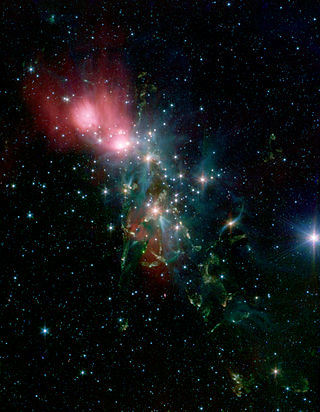
NGC 1333 is a reflection nebula located in the northern constellation Perseus, positioned next to the southern constellation border with Taurus and Aries. It was first discovered by German astronomer Eduard Schönfeld in 1855. The nebula is visible as a hazy patch in a small telescope, while a larger aperture will show a pair of dark nebulae designated Barnard 1 and Barnard 2. It is associated with a dark cloud L1450. Estimates of the distance to this nebula range from 980–1,140 ly (300–350 pc).
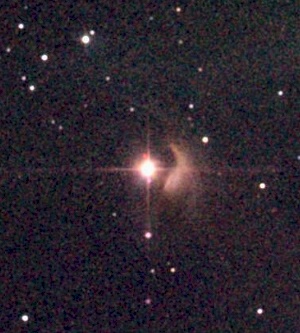
NGC 1555, sometimes known as Hind's Variable Nebula, Sh2-238 or HH 155, is a variable nebula 4 light years across, illuminated by the star T Tauri, located in the constellation Taurus. It is 400 light years away from Earth, and has a magnitude (B) of 9.98. It is also in the second Sharpless catalog as 238. It is a Herbig–Haro object. The nebula was discovered on October 11, 1852, by John Russell Hind.
NGC 6738 is an astronomical feature that is catalogued as an NGC object. Although listed as an open cluster in some astronomical databases, it may be merely an asterism; a 2003 paper in the journal Astronomy and Astrophysics describes it as being an "apparent concentration of a few bright stars on patchy background absorption".

NGC 1893 is an open cluster in the constellation Auriga. It is about 12,400 light years away. The star cluster is embedded in the HII region IC 410.

Gemini is one of the constellations of the zodiac and is located in the northern celestial hemisphere. It was one of the 48 constellations described by the 2nd century AD astronomer Ptolemy, and it remains one of the 88 modern constellations today. Its name is Latin for twins, and it is associated with the twins Castor and Pollux in Greek mythology. Its old astronomical symbol is (♊︎).

NGC 6067 is an open cluster in the constellation Norma. It is located to the north of Kappa Normae, with an angular diameter of 12′. Visible to the naked eye in dark skies, it is best observed with binoculars or a small telescope, and a 12-inch aperture telescope will reveal about 250 stars. Discovered by James Dunlop in 1826, it has been described by John Herschel as "a most superbly rich and large cluster" and by Stephen James O'Meara as "one of the sky's most stunning open star clusters". Its brightest stars have an apparent magnitude of around 8. There are 84 member stars with an apparent magnitude brighter than 12.
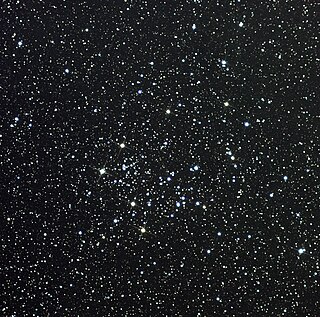
NGC 1746 is an asterism in the constellation Taurus that was described in 1863 by Heinrich Louis d'Arrest and as a result was recorded in the New General Catalogue (NGC). Previously, the object was classified as an open cluster; however, it was shown through more recent observations that it is a random formation of stars in Earth's sky, an asterism. NGC 1746 has an apparent magnitude of 6.1 and an apparent size of about 40'.
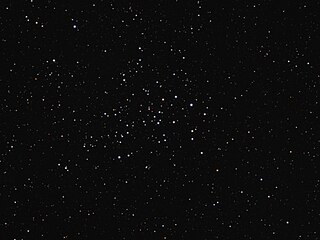
NGC 1528 is an open cluster in the constellation Perseus. It was discovered by William Herschel in 1790. It is located in the north-eastern part of the constellation, just under 3 degrees north of μ Persei. Less than 1.5° to the southeast is the open cluster NGC 1545. The NGC 1528 is clearly visible with 10x50 binoculars. 165 stars are recognised as members of NGC 1528, the brightest of which has apparent magnitude 8.7.

NGC 1817 is an open cluster of stars in the constellation Taurus. It was discovered by English astronomer William Herschel in February 1784. With an apparent magnitude of 7.7 and spanning 9.3 arc minutes across the sky, it is separated from the NGC 1807 cluster by just 26 arc minutes. Indeed, the two may actually be parts of a single extended cluster.

NGC 361 is an open cluster in the Small Magellanic Cloud. It is located in the constellation Tucana. It was discovered on September 6, 1826, by James Dunlop. It was described by Dreyer as "very very faint, pretty large, very little extended, very gradually brighter middle." At an aperture of 31.0 arcseconds, its apparent V-band magnitude is 12.24, but at this wavelength, it has 0.40 magnitudes of interstellar extinction.

NGC 1996 is an open cluster or a group of stars located in the Taurus constellation. It was discovered by William Herschel on December 7, 1785. NGC 1996 is located around 1400 pc from the Solar System and it is roughly 282 million years old and its apparent size is 22 arcmin.
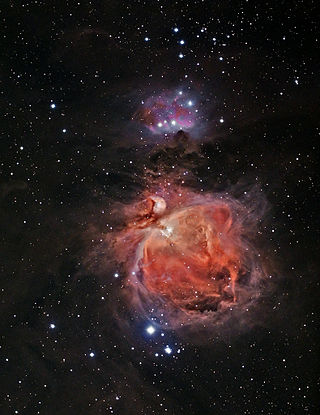
NGC 1981 is an open cluster which is located in the constellation Orion. It was discovered by John Herschel on 4 January 1827. Its apparent magnitude is 4.2 and its size is 28.00 arc minutes. It lies to the north of the Orion Nebula, separated from it by the Sh2-279 region containing NGC 1973, 1975, and 1977.
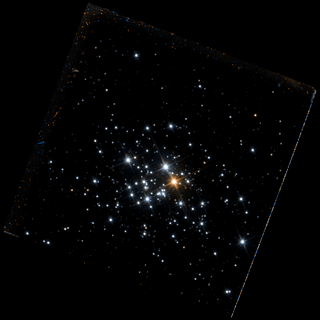
NGC 1984 is an open cluster associated with an emission nebula, it is located in the constellation Dorado in the Large Magellanic Cloud. It was discovered by John Herschel on 16 December 1835. The apparent magnitude is 9.9 and its size is 1.50 by 1.20 arc minutes.

NGC 1969 is an open star cluster in the Dorado constellation and is part of the Large Magellanic Cloud. It was discovered by James Dunlop on September 24, 1826. Its apparent size is 0.8 arc minutes.

NGC 2266 is an open cluster in the constellation Gemini. Its apparent size is 5 arc minutes. Its distance is 3,400 parsecs (11,000 ly). It was discovered by German-British astronomer William Herschel on 7 December 1785.
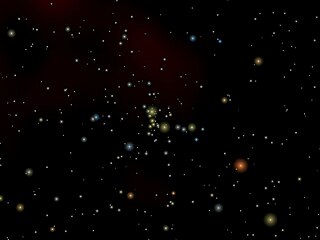
NGC 6910 is an open cluster in the constellation Cygnus. It was discovered by William Herschel on October 17, 1786. The cluster was also observed by John Herschel on September 18, 1828. It is a poor cluster with prominent central concentration and Trumpler class I2p. NGC 6910 is the core cluster of the stellar association Cygnus OB9.
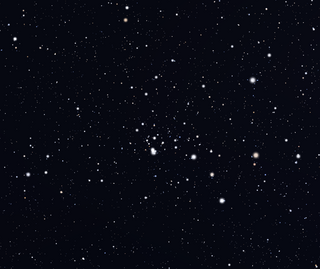
NGC 957 is a loosely bound open cluster located in the constellation Perseus. It has an apparent magnitude of 7.6 and an approximate size of 11 arc-minutes. It is young at less than 11 million years old.




















